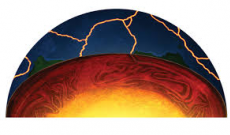

Management of tectonic hazards
Preparation means that governments, communities and individuals are ready to respond rapidly when disaster strikes and cope with the situation effectively. These measures include the formulation of emergency plans, the development of warning systems and the training of personnel. The measures may include evacuation plans for areas that may be at risk from a disaster and training for search and rescue teams. Preparedness therefore encompasses those measures, taken before a disaster event which are aimed at minimising loss of life, disruption of critical services and damage when the disaster occurs.
Mitigation measures are taken to reduce both the effect of the hazard and the vulnerability to it, in order to reduce the scale of the disaster. They can be focused on the hazard itself or on the elements exposed to the threat. Hazard-specific measures include relocating people away from the hazard-prone areas and strengthening structures, and using hazard resistant design to reduce damage when a hazard occurs.
Montserrat Case Study
Background information on the 1995 eruption
became active on July 18 1995
After lying dormant for centuries, the volcano on the island of Montserrat erupted. Two years later, two-thirds of the island was devastated by a further eruption.
The initial earthquake was small
The impacts of the eruption
Social
Many lost their homes and society
Many had to evacuate and never come back
19 people were killed
The capital was destroyed by pyroclastic flows
Environment
crops and plantations were destroyed
After the eruption most of the original population left
Forests were covered in layers of ash
Economic
lots o money needed to be spent off repairs
The islands hospital was destroyed
Effected tourism to begin with but then became a great tourist attraction
Management of the hazard
Planning protection
An exclusion zone was set up in the volcanic region
Hazard maps and evacuation plans were made
Prediction
villagers on Montserrat reported loud rumbling noises, a light ash fall and a strong sulphurous odour.
The eruption was preceded by 3 years of seismic activity and a more intense earthquake swarm began on July 14. Satellite imagery showed no signs of this eruption plume. On July 19 observers confirmed that small steam explosions were occurring in an area about 1.5kms northeast from the summit.
What is an earthquake?
An earthquake is a shaking and vibration of the crust due to movement of the earth’s plates (plate tectonics). Earthquakes can happen along any type of plate boundary. They are caused when the tension is released from inside the crust. This happens because plates do not move smoothly, sometimes they get stuck. When this happens a great deal of pressure builds up. When this pressure is eventually released, an earthquake tends to occur. The point inside the earth’s crust where the pressure is released is called the focus. The point above the focus, on the earth’s surface is called the epicentre. In an earthquake, energy is released in the form of waves. These are called seismic waves. The waves spread out from the focus. The strongest waves are found near the centre of the earthquake. This means that the most severed damage caused by an earthquake will happen closest to the epicentre.
Image- https://www.earthmagazine.org/article/when-and-how-did-plate-tectonics-begin-earth

0 Comment:
Be the first one to comment on this article.